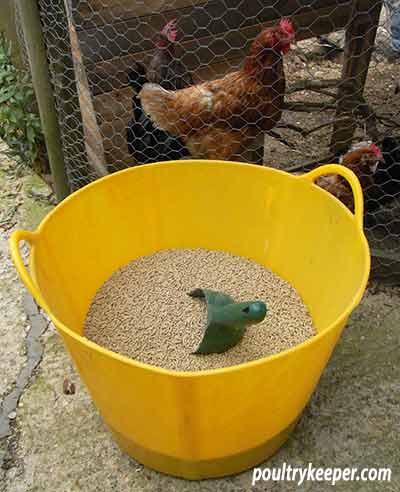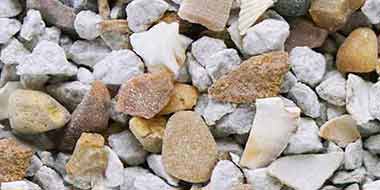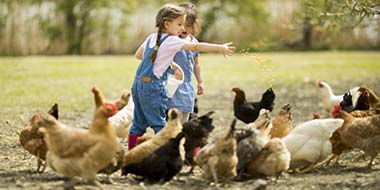Have you ever wondered what all of those different ingredients were in commercial poultry feeds? Poultry nutrition is a complex topic, so I asked Dr. Deepa, Assistant Professor at the Centre for Advanced Studies in Poultry Science to give us a run down of the possible ingredients that could be found in poultry rations.
Poultry nutrition needs to be more specific compared to ruminants as they are simple stomached and lack teeth. The nutritional necessities of poultry are basically expressed in terms of crude protein and energy content per kilogram of feed.
Birds reared for various purposes and in different age groups vary widely in their requirement. Generally, [in a commercial set-up], it is seen that feed alone accounts for 60-70% of the cost of production of meat and eggs. So any attempt to improve the economics of poultry rearing essentially should encompass nutritional management.
The digestive system
The digestive system of poultry is quite different from other animals as they lack teeth. The major parts are the crop (an extension of the oesophagus). This is followed by the proventriculus, the glandular stomach and gizzard, the muscular stomach. Digestive enzymes and acids are produced in the former while the latter mechanically grind the food. The addition of poultry grit in feeds further aids digestion as they may be present in the gizzard.
Poultry feed ingredients
 The major nutrients in feed include water, proteins, carbohydrates, fats and oils, minerals, vitamins and feed additives. Their utilization varies with the digestibility of the nutrients and bioavailability for metabolism.
The major nutrients in feed include water, proteins, carbohydrates, fats and oils, minerals, vitamins and feed additives. Their utilization varies with the digestibility of the nutrients and bioavailability for metabolism.
Formulating a balanced ration for feeding chickens needs to consider the digestibility, bioavailability, presence of anti-nutritional and toxic factors etc. Rations usually contain 16-28% crude protein and 2500 -3200K calories of Energy per kilo of feed.
As no single feed ingredient can supply all the essential nutrients at the required level, we go for combinations of feedstuffs in the poultry nutrition ration. The feed may be formulated using as few as 5-6 ingredients, or it may go up to 15-18 when micronutrient sources and feed additives are added.
This, in turn, has led to greater importance being attached to the quality control procedures in feed manufacturing. Poultry farmers preparing feed on their own often experience wide variations in the performance of birds even though the formulations, proximate principles, texture etc., remain almost the same. This may be due to the fluctuations in the quality of nutrients present in each raw material.
Non-Nutritional Feed Additives
There are certain compounds that can be added to poultry feed for their special significance. A list of these compounds is given below:
- Antibiotics-Bacitracin, chlortetracyeline (aureomycin) oxytetra-cycline (terramycin), procaine penicillin, streptomycin etc. These help in checking infections through gut and thus birds improve in condition. These can be used at low levels as growth promoters in young chicks.
- Arsenicals – Arsenilic acid (para-amino hydroxy phenyl arsenic acid), sodium arsenilate, 3-nitro-4-hydroxy phenylarsonic acids. The supplementation of the compounds also helps in improvements of growth in young chicks.
- Drugs – various coccidiostats, histomonostats, deworming drugs and other drugs are added for controlling specific diseases like coccidiosis, roundworms etc.
- Hormones and hormone-like preparations-Iodinated casein, other iodinated proteins, estrogenic preparations like stilbesterol diethylbesterol, dienesterol diacetate, etc. are added sometimes for improving carcass quality and quantity.
- Antioxidants– The following antioxidants are added to prevent oxidation of fat and certain other vulnerable compounds like vitamin E. DPPD (diphenyl-paraphenylene diamine)BHA (Butylated hydroxyanisol)BHT (Butylated hydroxytoluene)Propyl gallate, etc.
- Antifungals-Sodium benzoate, other benzoates, Sodium propinate, sorbic acid etc. help in preventing fungal diseases.
- Flavouring agents.
- Pellet binders like sodium bentonite.
- Pigments– xanthophyll and other carotenoid sources-for causing bright egg yolk colour
- Enzymes – Enzymes are proteins which have the property of catalyzing specific biochemical reactions. Protease, xylanase, glucase,and many more enzymes.
- Probiotics – are live yeast cultures of natural and beneficial bacilli, which can be introduced into the animal gut in massive numbers to supplement the already present ones, to compete with the pathogenic organisms. Lactic acid bacilli, vitamin mineral premix, antibiotic supplements, arsonic acid supplements, DL- methionine and pigments.
The other additives that can be added are preservatives, emulsifiers and stabilizers, food colours, flavours, sequestrants, anticaking agents, acids, buffers and bases, humectants, firming and crisping agents and sweeteners.
As you can see, poultry nutrition can be quite complex and formulated feeds can contain many different ingredients. There is also a good page on basic poultry nutrition here on The Poultry Extention Website.


